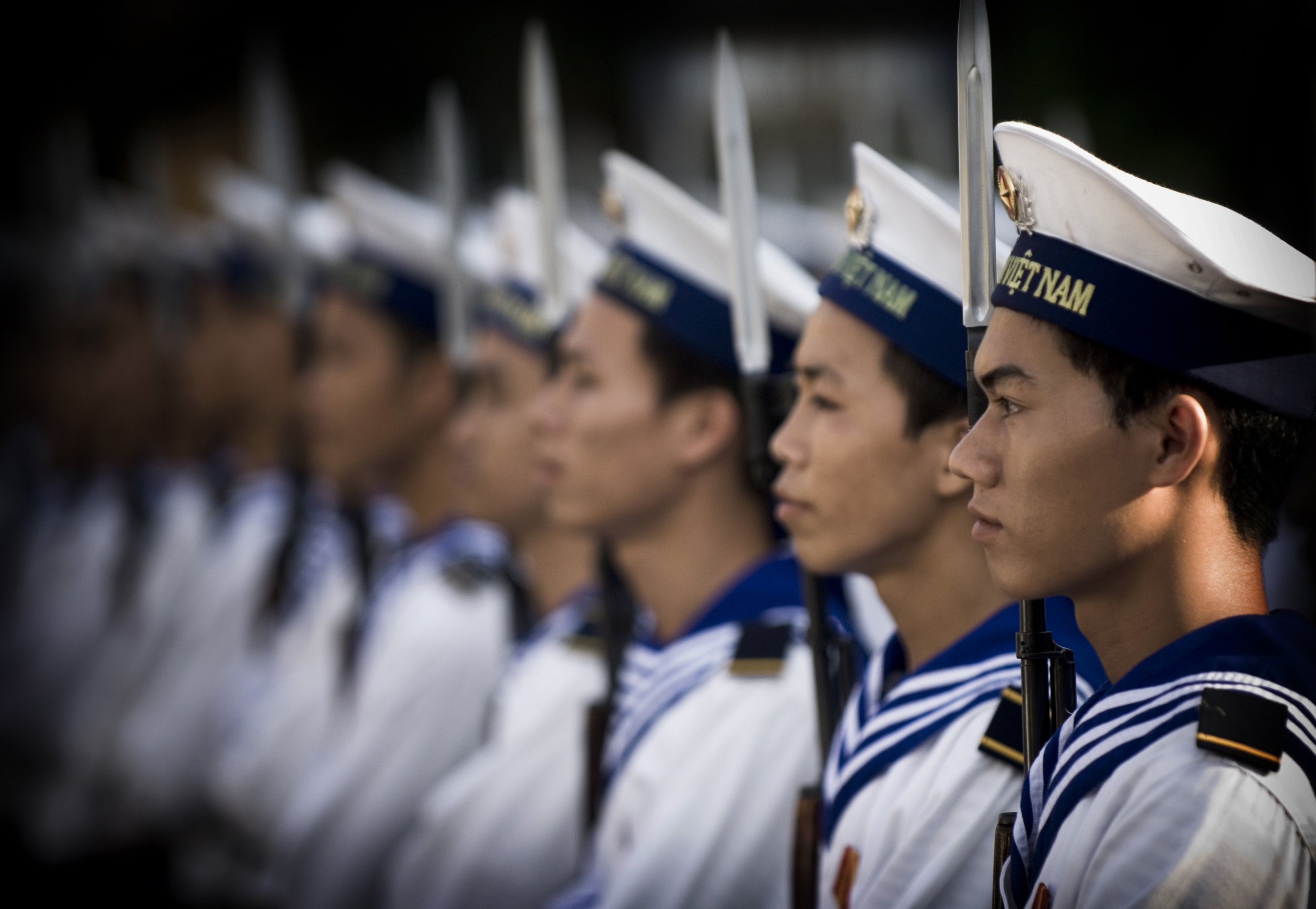A nation must think before it acts.
Without a doubt, the Southeast Asian country most willing to challenge Chinese claims in the South China Sea has been Vietnam. Its government and people have long resisted China. Vietnam famously fought its most recent war against China in 1979. But what is often forgotten is that the two sides continued to intermittently fight pitched battles over the next 12 years. Though Vietnam fared well on land, it did not at sea. In 1988, China and Vietnam skirmished over then-Vietnamese-occupied Johnston South Reef in the South China Sea. When the smoke cleared, some 64 Vietnamese naval personnel were dead, and China had captured the reef. With its navy too weak and its superpower benefactor, the Soviet Union, in no mood to confront China, Vietnam could do little to reclaim its lost territory.
Given such history, Vietnam has good reason to eye Chinese actions with suspicion. As a result, the growth of Chinese naval forces in the South China Sea since the early 2000s was bound to raise eyebrows in Hanoi. Vietnam recognized that China’s new capabilities would put not only its remaining outposts in the Spratly archipelago at higher risk, but also its entire coastline. If allowed uncontested control of the waters within its self-proclaimed “nine-dash line” in the South China Sea, China could not only threaten Vietnam’s offshore oil and natural gas interests, but also turn its eastern flank in a future border conflict. Hence, Hanoi responded by building a bigger and more capable navy.
Vietnamese Naval Buildup
Until the early 2000s, the Vietnamese navy was largely comprised of an assortment of retired warships either captured from South Vietnam or transferred from the Soviet Union. Still, it was a force not without some modern naval combat capabilities. Armed with SS-N-2 anti-ship missiles, its eight Osa II-class fast attack craft and four Tarantul-class corvettes would have constituted a reasonably credible threat to an amphibious force attempting to land at Hai Phong, the historic coastal gateway to Hanoi.
After the Cold War, the Vietnamese navy sought to gain experience with submersibles, acquiring two North Korean Yugo-class midget submarines in 1997. The navy also added a handful of coastal combatants, but did so at a very slow rate. One small corvette, only 525 tons, took five years from order to completion and was the navy’s only ship to be armed with newer anti-ship cruise missiles at the time. Thus, Vietnam’s navy remained too small and too oriented toward coastal combat to effectively assert Vietnamese claims in the relatively distant Paracel and Spratly Islands.
Though that situation was surely not ideal for Vietnam, it was tolerable so long as no other South China Sea claimants aggressively asserted their claims. But then China did just that, as its maritime power grew through the 2000s. Not long afterwards, Vietnam began a major naval buildup. In rapid succession, it ordered four Gepard-class frigates and eight Tarantul V-class corvettes from Russia, all of which are armed with multiple supersonic SS-N-25 anti-ship cruise missiles. In 2009, it also purchased six Russian Kilo-class diesel-electric submarines, at a cost of $2 billion or the equivalent of half its entire annual defense budget. The scale of the Vietnamese navy’s expansion has been impressive. All the navy’s submarines, four of its nine frigates, and eight of its 13 corvettes were commissioned in just the last dozen years. While little is known about the navy’s future procurement plans, at least two more Tarantul V-class corvettes are expected and two additional Gepard-class frigates are reportedly under negotiation.
In the meantime, Vietnam did not neglect its coastal defenses. In 2011, it ordered two Russian K-300P Bastion-P coastal defense systems. Each system supports a mobile battery of P-800 land-based anti-ship cruise missiles. Now deployed along Vietnam’s coastline, the batteries extend the maritime space that Vietnam can defend to a depth of between 130 and 250 km out to sea. (The variation in range depends on the particular flight trajectories of the missiles.) If delivered in a single pulse, a salvo of eight missiles from one battery could penetrate even China’s best shipboard anti-missile defenses. At the same time, the batteries’ mobility would hinder China’s ability to suppress them with air or ballistic missile strikes.
Vietnamese Naval Strategy
Given its naval buildup, Hanoi appears to be preparing itself for future confrontations with China. One could see Vietnam’s acquisition of new missile-armed coastal combatants and land-based anti-ship missile batteries as a sign of that. Although such coastal defense forces are mainly intended to protect the Vietnamese coast rather than its outlying islands, they serve as a useful hedge against any escalatory action that China might take in response to being challenged at sea. Indeed, Vietnam is expected to further beef up those forces (and those of its coast guard) in the years ahead.
Meanwhile, Vietnam’s procurement of submarines offers a strong clue as to what its maritime aim is. Submarines are critical to any modern sea control or sea denial strategy. Having acquired only six submarines so far, Vietnam is likely pursuing the latter—denying its adversary the ability to safely operate in the South China Sea. But with even that number of submarines, the Vietnamese navy can keep two of its boats on patrol at any given time. And, if tensions were to rise, it could surge the rest. No doubt they would complicate Chinese naval operations and force China’s navy to devote anti-submarine warfare resources to hunt for them.
Vietnam has also hardened the defenses on the islands that it occupies in the Spratly archipelago. Soon after China accelerated the construction of military facilities in the region during the early 2010s, Vietnam followed suit. Reportedly, in 2016, it even deployed rocket launchers with sufficient range to strike nearby Chinese-held islets. If true, their role in the event of hostilities is likely to neutralize China’s airfields and radar systems on those islets, and thereby improve the odds for Vietnamese naval forces at sea.
Still, the goal behind all the efforts by Vietnam to strengthen its naval posture may ultimately be to raise the cost of Chinese encroachment on its South China Sea claims. If so, it has been only partly successful. Certainly, Vietnam has not lost any more territory. Nor have Vietnamese fishermen had to endure the level of harassment that their Filipino counterparts have, at least as measured by the frequency of media reports. But China has repeatedly intruded on swaths of Vietnam’s exclusive economic zone that fall within its “nine-dash line.” In one well-reported case in 2014, China stirred up controversy when it sent the Hai Yang Shi You 981 offshore drilling rig into Vietnamese-claimed waters. Most recently, it dispatched an energy exploration ship, the Haiyang Dizhi 8, to conduct seismic surveys in one of Vietnam’s offshore energy blocks just 100 km off the Vietnamese coast in July and again in August.
Unpredictable Tides
Like Vietnam, the Philippines had become alarmed by China’s behavior in the South China Sea. During the presidency of Benigno Aquino III, Manila sought to create a common front with Hanoi. Initially, Vietnam was wary. It was unsure about how cooperation might impact its claims—not to mention the reliability of the Philippines as a partner, given its turbulent domestic politics and puny naval strength. But eventually, Vietnam was persuaded. In 2014, it increased its military exchanges with the Philippines and sent two of its newest Gepard-class frigates to Subic Bay to promote naval cooperation. Philippine and Vietnamese soldiers stationed in the Spratly Islands even came together once to enjoy soccer and volleyball in a show of unity. China dismissed the event, calling it “a farce.”
As it turned out, Hanoi’s concerns over Philippine reliability were justified. Aquino’s successor, Rodrigo Duterte, radically altered his country’s approach toward China in 2016. Rather than challenge China, the Philippines would cooperate with it. And so Vietnam lost what it had hoped would be an ally on the South China Sea issue within ASEAN. In the meantime, China leveraged its economic ties with other ASEAN countries, like Cambodia, Laos, and Malaysia, to mute regional criticism over its activities.
To break free of its increasing isolation, Vietnam has bolstered its security relationships with major powers outside of Southeast Asia, including India, Japan, and the United States. In fact, Vietnam’s submariners are now trained by the Indian navy, which operates the same class of submarines.[1] Vietnam also built a maritime facility to maintain and refuel foreign warships near its Cam Ranh Bay Naval Base, which happens to be the headquarters for the portion of the Vietnamese navy responsible for the Spratly Islands. Since the facility’s opening in 2016, the vast majority of the ships that have docked there have been from countries that have expressed some sort of opposition to China’s maritime activities, including Australia and France. American and Japanese ships have visited the most. Vietnam seems “to be reminding China of just how many friends and suitors it has—and just how well it can look after their warships.”[2]
Getting Some Respect
For decades, Beijing and Hanoi have tussled over the waters of the South China Sea. But how China now deals with Vietnam at sea has begun to diverge from how it deals with other claimants, like the Philippines. When China sent the Haiyang Dizhi 8 into Vietnam’s exclusive economic zone, it provided the ship with a strong escort of four large coast guard vessels. Rarely does it do so when sending ships into waters claimed by the Philippines. In short, China may have come to regard Vietnam’s maritime capabilities with a measure of respect.
Of course, that does not mean China has backed off on its South China Sea claims. It continues to meddle in Vietnam’s offshore energy exploration activities. In 2018, Chinese pressure forced Spain’s Repsol to halt a project off Vietnam’s southern coast, “costing the company and its partners as much as $200 million.” Then in 2019, Chinese coast guard vessels used their water cannons to hamper a Vietnamese offshore drilling rig working for Russia’s Rosneft on another project.[3] The spat is over the Ca Voi Xanh (Blue Whale) project, led by America’s ExxonMobil. If fully developed, the project could produce 8-9 billion cubic meters of natural gas per year and generate $20 billion in revenues for Hanoi. Even though Blue Whale’s natural gas field is clearly outside of China’s “nine-dash line,” it is close enough that China has leaned on ExxonMobil to cut its ties to the project.
If Vietnam is to counter such Chinese pressure, then it will have to prove to companies, like ExxonMobil, that it can protect its offshore blocks. But, despite its bigger navy, Vietnam has struggled to close the power gap between it and China, whose own naval expansion has yet to slow. Fortunately for Vietnam, its economy has grown briskly over the last half decade. The trade war between China and the United States will likely boost it even further, as international supply chains shift from China to Vietnam. That is bound to benefit Hanoi’s coffers. Already, Vietnamese government revenues have been rising by more than ten percent a year from 2015 to 2018. Hanoi would be wise to spend a good portion of those revenues on its navy. After all, getting respect is one thing, keeping it is another.
[1] Jon Grevatt, “India, Vietnam to deepen defence trade ties,” Jane’s Defence Weekly, Mar. 5, 2018.
[2] “Dock and cover,” Economist, Apr. 20, 2017.
[3] Spain’s Reposol tried to develop the Ca Rong Do (Red Emperor) oil and natural gas field in Block 07/09 and Russia’s Rosneft is developing the Lan Do (Red Orchid) natural gas field in Block 06.1. Both blocks are off Vietnam’s southeastern coast, but within China’s “nine-dash line” in the South China Sea.




